I. Introduction
The ATO Cost Database is a unique collection of about 1,200 transport-related projects in the Asia-Pacific economies. The main objective of the database is to provide insights on transport infrastructure cost data to MDBs, Policy makers and Civil Society. The ATO cost database not only provides the cost details on USD and local costs but also on PPP terms which facilitates comparisons and benchmarking.
The present form includes extensive project data collection from ROCKs database, other secondary sources, and individual ADB project reports. The projects are also classified by the different project types.
II. Structure of the ATO Cost Database
The database provides information about the transport projects that can help in describing the data such as economy, city, project type, infrastructure length, costs (in local currency, nominal USD, PPP USD, unit cost, cost type, sources, and other remarks).
A. Project types
The project types are currently categorized into 6 major typologies
1. Active Mobility Project
- Elevated Walkway
2. Air Transport
- Airport Infrastructure
3. Rail Transport (non-urban)
- Heavy Railway Construction
- Heavy Railway Electrification
- High Speed Railway
4. Road Asset Management
- Asphalt Mix Resurfacing
- Bituminous Pavement Preventive Treatment
- Gravel Resurfacing
- Partial Widening and Reconstruction
- Reconstruction
- Routine Maintenance
- Strengthening
- Surface Treatment Resurfacing
- Upgrading
- Upgrading and Climate Proofing
5. Road Construction
- New 1L Road
- New 2L Highway
- New 2L Highway with Climate Proofing
- New 4L Expressway
- New 6L Expressway
- Partial Widening
- Widening
- Widening and Reconstruction
6. Urban Public Transport
- BRTS
- Commuter Rail
- Light Rail
- Metro
- Monorail
B. Project cost
The project costs are provided in various forms depending on the source. All costs are eventually converted to PPP USD total cost and PPP USD unit cost.
- Local currency is based on the currency of the economy as reported by the source. If converted from nominal USD, exchange rate during the year of estimate is used.
- Nominal USD is the cost in USD as reported by source at the year of estimation. The cost is unadjusted for inflation and parity.
- PPP USD is the cost in USD adjusted for inflation and parity from nominal USD cost. Conversion rate is based on the year of estimate.
- Unit cost is the PPP USD cost divided by the reported infrastructure length.
C. Other project information
- Length is the reported length of the infrastructure development in kilometers.
- Cost type indicates if the cost reported is based on estimate or based on actual cost incurred by the project.
- Year indicates when the estimate was made or construction was started.
- Source provides a link to the original source of the project information.
- Remarks details supplementary information regarding the record of the project such as project subcomponents or assumptions made regarding the costs.
D. Economy metadata
The ATO economies are also tagged with economy metadata. In addition to the project information, the economy metadata will also help filter down the desired data.
- Subregion is based on ADB Asia-Pacific subregion definition. For Russia and Iran (Islamic Republic of), they are assigned under Others (Central and West Asia, East Asia, Pacific, South Asia, South East Asia, or Others)
- Income Group is based on World Bank income grouping (Low income, Lower middle income, Upper middle income, High income)
- Groups includes various typologies of economies, associations, organizations, and cooperation groupings (Least Developed Countries (LDC), Landlocked Countries (LLC), Small Island Developing States (SIDS), ADB Member, Asia-Pacific Economic Cooperation, Association of South East Asian Nations (ASEAN), Central Asia Regional Economic Cooperation (CAREC), G20, Greater Mekong Subregion (GMS), Organisation for Economic Co-operation and Development (OECD), Pacific Islands Forum (PIF), Regionally Environmentally Sustainable Transport (EST) Forum, Shanghai Cooperation Organisation (SCO), South Asia Subregional Economic Cooperation (SASEC), South Asian Association for Regional Cooperation (SAARC))
E. ATO Cost Database raw data
The ATO Cost Database is also available in an Excel version. The table is provided with filters for economy, city, income level, subregion, and as well as the project type and typology. Summary tables are also provided on separate sheets for unit costs per subregion, per income level, per economy, and per project type.
III. How to explore the ATO Cost Database
A. Create a search
Within the ATO Cost Database interface, the space on the left will contain panels that filter data by economies, project type, and time. To view the list of projects or summary tables, all parameters (i.e. economy, project type, and time) need to have a selection.
1. Economies panel
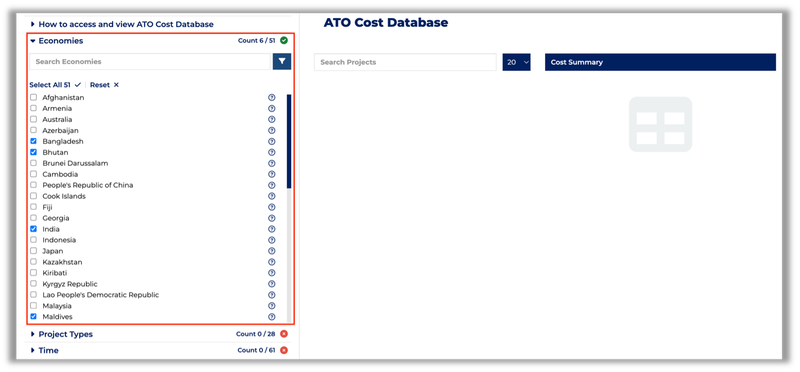
Individual economies can be selected by clicking on the checkbox. All economies can be selected by clicking Select All. The selection can be reset by clicking on Reset.
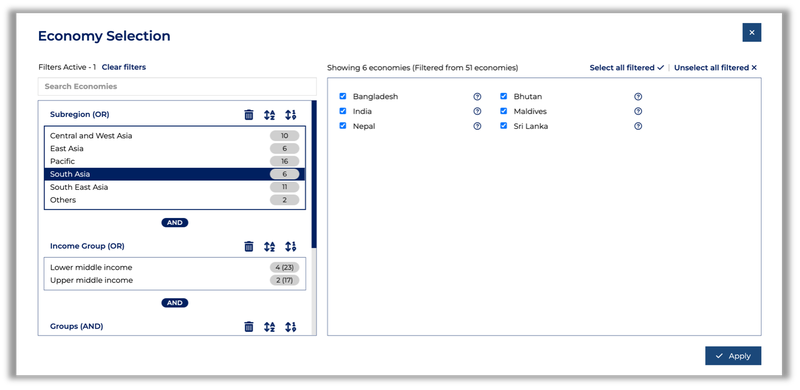
To filter by economy typology, click on the filter button to open the expanded filter window. The filters on the left (i.e. Subregion, Income Group, or other Groups) can be used to narrow down the list of economies.
Notes about filtering:
- Selecting filters within a category will expand the choices (e.g. economies that are either Low income OR Lower-middle income)
- Selecting filters across categories will narrow down the choices (e.g. economies that are both in East Asia AND also High income)
2. Project Types panel

The project types are currently categorized into 6 major typologies. Individual project types can be selected by clicking on the checkbox. All project types under a typology can be selected by clicking on the checkbox beside the typology. The selection can be reset by clicking on Reset.
3. Time panel
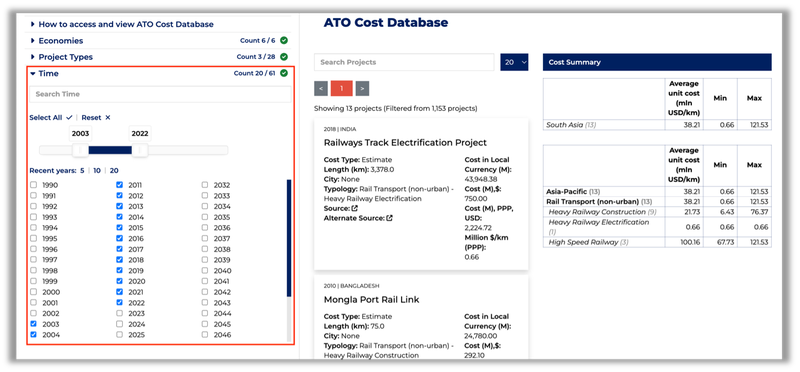
The desired project timeframe can be selected per year by clicking on the checkbox or you can use the slider to select a range of years. All available years can be selected by clicking on Select All. The selection can be reset by clicking on Reset.
Shortcuts are available to quickly select recent 5, 10, or 20 years.
D. List of projects
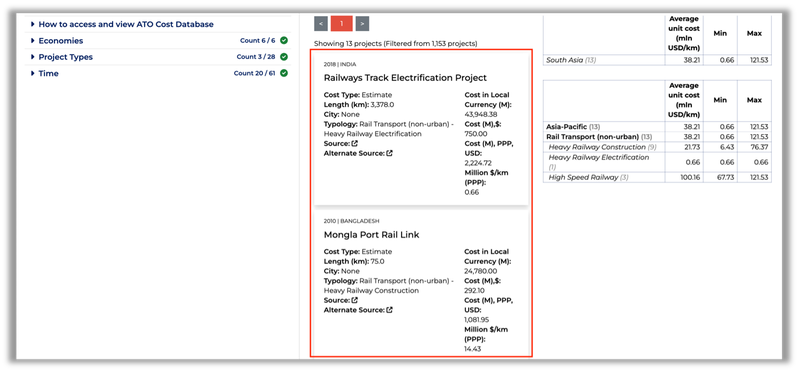
Within the ATO Cost Database interface, the space on the middle will provide a list of projects filtered according the economy, project type, and years selected.
1. Searchbox
The searchbox can be used to look for specific projects based on the project name or metadata.
2. Project card
Each project will be displayed as a card with additional information such as city, length, cost type, source, costs in various forms, and unit cost of the project. A Download button is available to download the filtered list of projects into an Excel file.
C. Summary tables
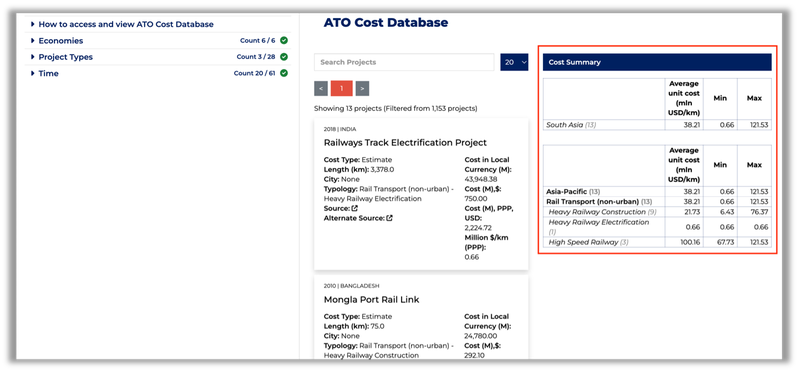
Within the ATO Cost Database interface, the space on the right will provide summary tables based on selected filters. The table will provide average cost, minimum cost, and maximum cost per row. A number indicated beside the row item indicates the number of project considered for that row.
A Download button is also available download all the summary tables into an Excel file.
- Project cost per subregion is based on ADB Asia-Pacific subregion definition. For Russia and Iran (Islamic Republic of), they are assigned under Others (Central and West Asia, East Asia, Pacific, South Asia, Southeast Asia, or Others). This summary appears only when the selected economies complete a subregion group.
- Project cost per income group is based on World Bank income grouping (Low income, Lower middle income, Upper middle income, High income). This summary appears only when the selected economies complete an income group.
- Project cost per economy is based on the 51 ATO economies. This summary appears if only one project type.
- Project cost per project type lists the summary by the different project types. This summary appears all the time when all the parameters are selected.